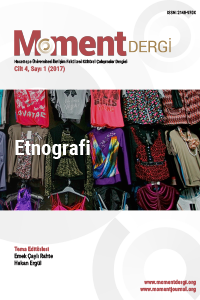Abstract
Medya ve toplumsal değişimi inceleyen etnografik yaklaşımlar, araştırma objesi olarak çoğunlukla yeni bir iletişim aracının ortaya çıktığı noktadaki değişimlere odaklandığından, yeni teknolojinin dönüştürücü gücünü fazlasıyla öne çıkarma eğilimi göstebilmektedirler. Bu yüzden Postill, medyanın toplumsal değişime olan etkisini anlamak için belli bir zamanla kısıtlandırılmış etnografik yöntemler yerine, devam etmekte olan toplumsal değişimin altını çizebilecek biyografik bir yöntemin gerekliliğini savunmaktadır. Kendisinin bu sayıdaki makalesine yaptığım yorum, kendi uzun-süreli medya etnografisi araştırmamdan da örneklerle ve Buroway’un (2003) sahaya odaklı ve kesintili geri dönüş yönteminden yola çıkarak, uzun-süreli bir medya etnografisi yaklaşımının önemine vurgu yapmaktadır.
References
- Abu-Lughod, L. (2016). Veiled Sentiments Honor and Poetry in a Bedouin Society (30th Anniversary Edition ed.). Berkeley: University of California Press.
- Algan, E. (2013). Youth, New Media, and Radio: Mobile Phone and Local Radio
- Convergence in Turkey. In M. Hilmes & J. Loviglio (eds.), Radio's New Wave: Global Sound in the Digital Era (pp. 79-90). New York: Routledge.
- Burawoy, M. (2003). Revisits: An Outline of a Theory of Reflexive Ethnography. American Sociological Review, 68(5), 645-679.
- Kottak, C. P. (2012). Prime-Time Society: An Anthropological Analysis of Television and Culture (Updated edition ed.). New York and London: Routledge.
- La Pastina, A. C., Straubhaar, J., & Sifuentes, L. (2014). Why Do I Feel I Don’t Belong to the Brazil on TV? Popular Communication: The International Journal of Media and Culture , 12(2), 104-116.
- O'Connor, H., & Goodwin, J. (2012). Revisiting Norbert Elias's sociology of community: learning from the Leicester re-studies. The Sociological Review, 60(3), 476–497.
- O'Reilly, K. (2012). Ethnographic returning, qualitative longitudinal research and the reflexive analysis of social practice. The Sociological Review, 60(3), 518–536.
- Pace, R. &. (2013). Amazon Town TV: An Audience Ethnography in Gurupá, Brazil. Austin: University of Texas Press.
- Peacock, J. (1968). Rites of modernization: social and symbolic aspects of Indonesian proletarian drama . Chicago: University of Chicago Press.
- Peterson, M. A. (2009). Response to John Postill. Social Anthropology, 17(3), 337–340.
- Philipson, C. (2012). Community studies and re-studies in the 21st century: methodological challenges and strategies for the future. The Sociological Review, 60(3), 537–549.
- Tucker, H. (2010). Peasant-entrepreneurs: A Longitudinal Ethnography. Annals of Tourism Research, 37(4), 927-946.
Abstract
Ethnographic examinations of media and social change can focus too narrowly on the changes taking place at the time of introduction of a new communication technology and thus can end up being incredibly short-sighted and celebratory in their approach. Postill argues that inquiries into media's role in social change should not be done through time-constrained ethnographic methods, but rather should follow a more biographical model that better accounts for ongoing social change. In response to his essay in this issue and in light of my fieldwork experience in the same site during the past 15 years, I discuss the value of adopting a longitudinal approach to media ethnographies with focused or punctuated revisits (Burawoy, 2003) to the field.
References
- Abu-Lughod, L. (2016). Veiled Sentiments Honor and Poetry in a Bedouin Society (30th Anniversary Edition ed.). Berkeley: University of California Press.
- Algan, E. (2013). Youth, New Media, and Radio: Mobile Phone and Local Radio
- Convergence in Turkey. In M. Hilmes & J. Loviglio (eds.), Radio's New Wave: Global Sound in the Digital Era (pp. 79-90). New York: Routledge.
- Burawoy, M. (2003). Revisits: An Outline of a Theory of Reflexive Ethnography. American Sociological Review, 68(5), 645-679.
- Kottak, C. P. (2012). Prime-Time Society: An Anthropological Analysis of Television and Culture (Updated edition ed.). New York and London: Routledge.
- La Pastina, A. C., Straubhaar, J., & Sifuentes, L. (2014). Why Do I Feel I Don’t Belong to the Brazil on TV? Popular Communication: The International Journal of Media and Culture , 12(2), 104-116.
- O'Connor, H., & Goodwin, J. (2012). Revisiting Norbert Elias's sociology of community: learning from the Leicester re-studies. The Sociological Review, 60(3), 476–497.
- O'Reilly, K. (2012). Ethnographic returning, qualitative longitudinal research and the reflexive analysis of social practice. The Sociological Review, 60(3), 518–536.
- Pace, R. &. (2013). Amazon Town TV: An Audience Ethnography in Gurupá, Brazil. Austin: University of Texas Press.
- Peacock, J. (1968). Rites of modernization: social and symbolic aspects of Indonesian proletarian drama . Chicago: University of Chicago Press.
- Peterson, M. A. (2009). Response to John Postill. Social Anthropology, 17(3), 337–340.
- Philipson, C. (2012). Community studies and re-studies in the 21st century: methodological challenges and strategies for the future. The Sociological Review, 60(3), 537–549.
- Tucker, H. (2010). Peasant-entrepreneurs: A Longitudinal Ethnography. Annals of Tourism Research, 37(4), 927-946.
Details
| Primary Language | English |
|---|---|
| Journal Section | Commentary Article |
| Authors | |
| Publication Date | June 15, 2017 |
| Submission Date | June 1, 2017 |
| Acceptance Date | June 1, 2017 |
| Published in Issue | Year 2017 Volume: 4 Issue: 1 - Ethnography |


